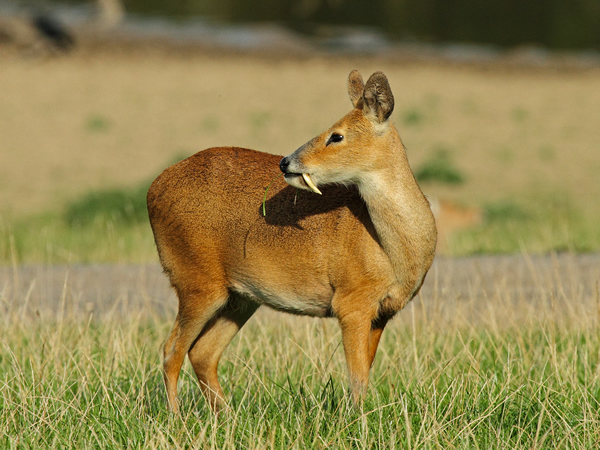 |
| Musk Deer |
Musk deer are so-named because the males of the species have a gland, called the pod, that develops in the skin of their abdomen. This gland produces a waxy substance called musk, which may be used by males to attract females.
An average musk deer has a head and body length of 28 to 39 inches (71 to 99 centimeters), stands 20 to 24 inches (51 to 91 centimeters) at its shoulder, and weighs between 15 and 40 pounds (7 and 18 kilograms). The musk deer’s hair is long and coarse. It varies in color from dark to golden brown, depending on the species.
The hind legs of a musk deer are almost one-third larger than its front legs. This helps to make the animal a quick and agile jumper. Unlike most other deer, musk deer have no antlers.
  |
The upper canine teeth of male musk deer grow into narrow, pointed tusks that curve down and backward from the animal’s mouth. Males use these 2.5- to 3-inch (6.3- to 7.6 -centimeter) teeth when fighting each other over the right to mate with females.
Mating takes place in November and December. A male musk deer pursues a female until she is too exhausted to run anymore. After a gestation (pregnancy) period of 150 to 198 days, a female musk deer gives birth to one or two infants, which are born with spotted coats.
Musk deer feed on leaves, flowers, twigs, mosses, grasses, and lichen (an organism formed by algae and fungus growing together) during morning and evening hours. Predators of musk deer include the lynx, wolf, fox, and yellow-throated marten (mammal related to the weasel and the mink).
Habitat and current distribution
Musk deer inhabit wet forests in the Himalayas, eastern Asia, and Siberia. During summer, the animals can be found in mountain forests ranging over 8,500 feet (2,600 meters) in elevation. They prefer dense vegetation and brush so they can easily find shelter during the day.
Wildlife biologists (people who study living organisms) are unsure of the total number of all species of musk deer in existence. They believe the population to be between 30,000 and 100,000. Of the five main species of musk deer, the Siberian musk deer (Moschus moschiferus) is the most threatened.
History and conservation measures
Humans have hunted musk deer not for their meat or hide, but solely for their musk, which is used in perfumes and medicines. Hunting and habitat destruction endanger the present-day survival of all musk deer species.
Musk deer do not have to be killed in order to extract their musk. A program to raise the animals and extract their musk without causing injury began in China in the late 1950s. After the program proved successful, similar programs were implemented in India, Nepal, and Russia.
